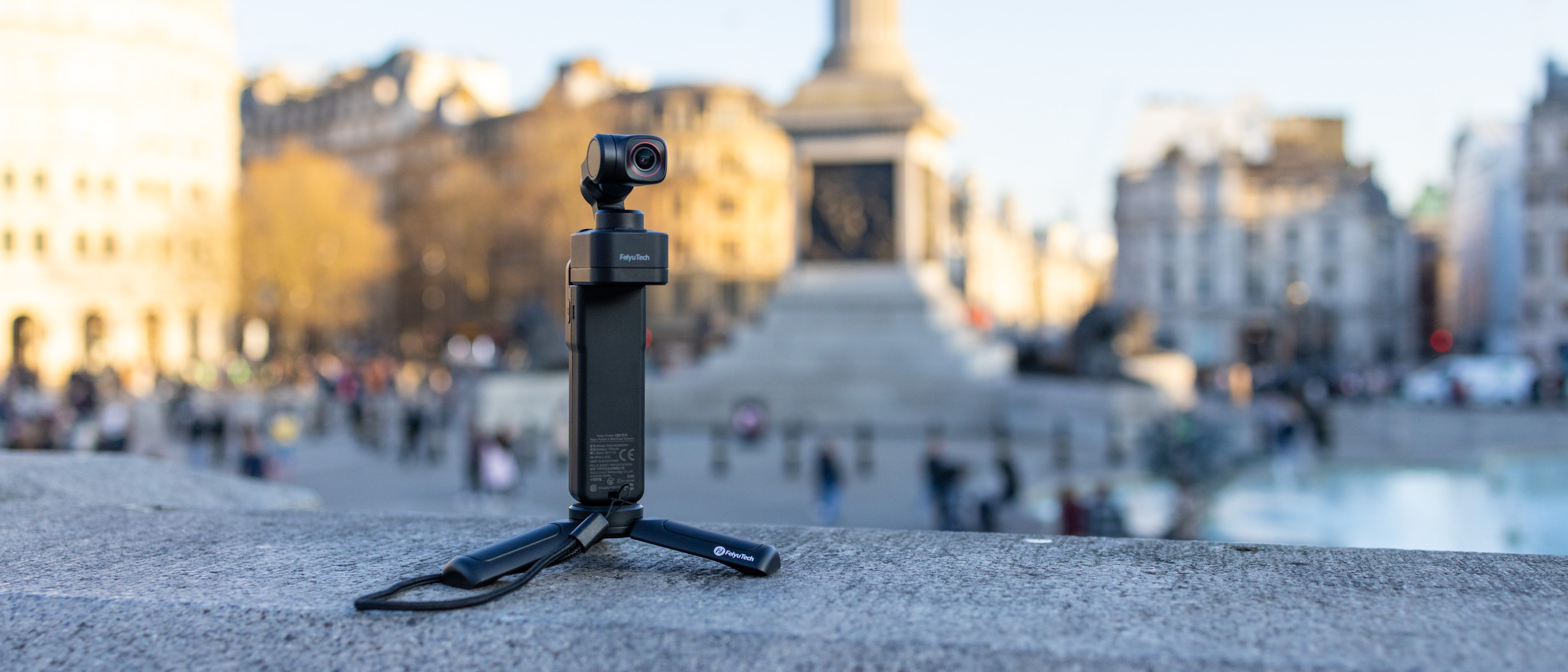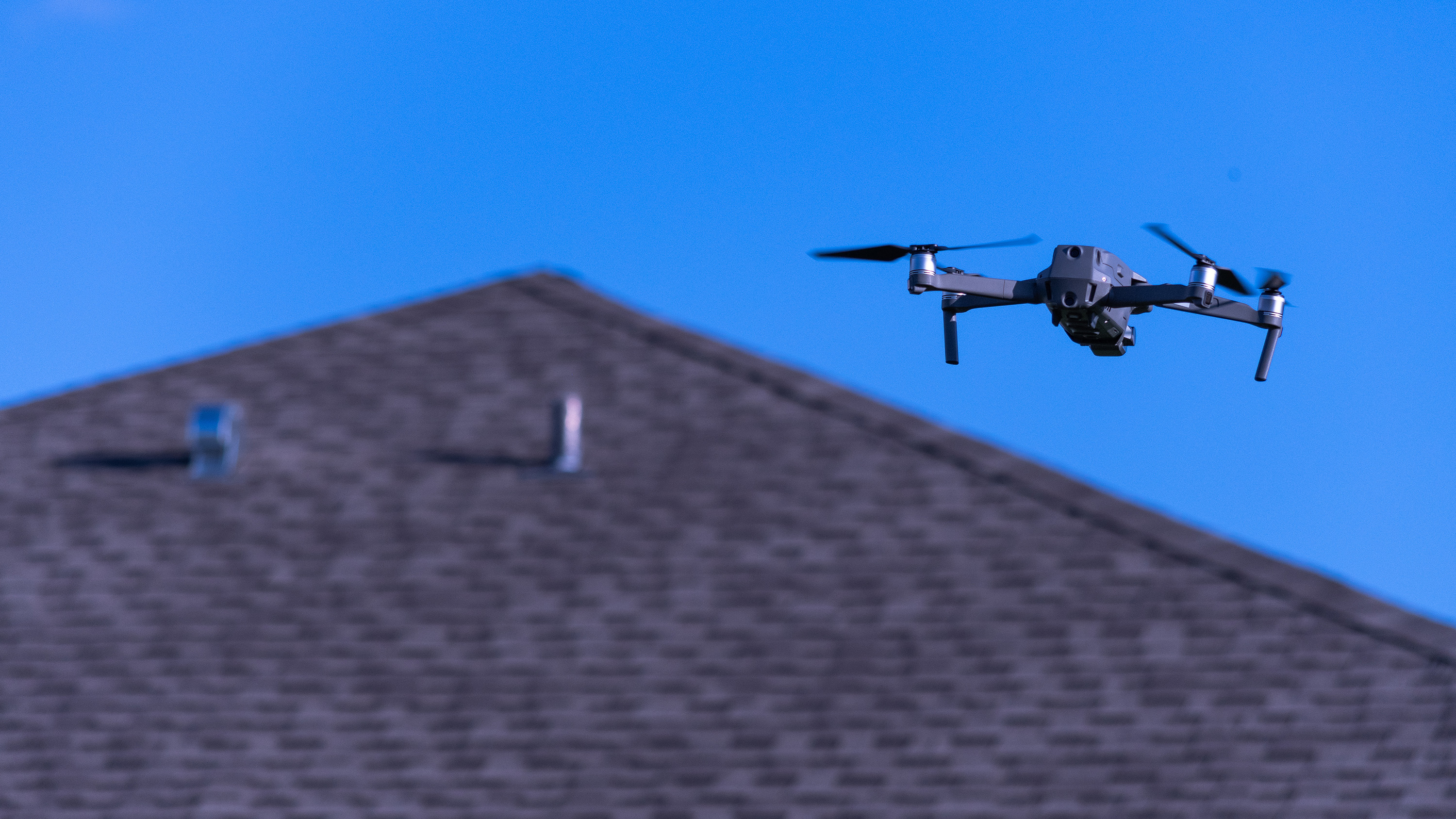Digital Camera World Verdict
The Feiyu Pocket 3 is a unique vlogging camera with a detachable wireless gimbal head and magnetic base, setting it apart from competitors like the DJI Osmo Pocket 3. While significantly more affordable, it makes compromises. Its image quality is fairly average, especially in low light, due to a smaller sensor. It lacks the better slow motion capabilities, 10-bit log recording, and extensive accessory ecosystem of the DJI. However, it excels in battery life and offers a wide 16mm lens with reliable autofocus and face tracking. The detachable gimbal and magnetic base provide creative shooting options, and the wireless connection works well. Its small screen and usability quirks are drawbacks, such as the lack of external mic support and omission of weather sealing. Despite these limitations, its innovative design and lower price point make it a compelling alternative for budget-conscious creators who value versatility over top-tier image quality.
Pros
- +
More affordable than its competition
- +
Has unique detaching gimbal head
- +
Magnetic base opens up creative possibilities for compositions
- +
Face detection tracking works well
Cons
- -
Poor low light performance
- -
Screen is small and can’t be rotated
- -
Not as many accessories for it as the DJI Osmo Pocket 3
- -
More vulnerable than an action camera
- -
Doesn't support external mics
Why you can trust Digital Camera World
Supply issues of the DJI Osmo Pocket 3 may have left those itching to get out vlogging looking to other cameras and FeiyuTech’s Pocket 3 is a tantalising proposition, not only because it’s half the price of the DJI Osmo Pocket 3 but because it has an utterly unique party trick – the ability to detach its gimbal head from its remote handle.
The Feiyu Pocket 3 is the third pocket vlogging camera from FeiyuTech and is the world’s first vlogging camera with a detachable and cordless gimbal. Its predecessor, the Pocket 2S offered a similar functionality as its head could be taken on and shot away from the remote but this was over a limiting wired connection.
The Feiyu Pocket 3 takes this concept one step further as its gimbal head can now be used completely independently, plugged into the handle for more functionality or use both separated from each other via a WiFi connection. You can even ditch Feiyu's handle altogether and use the screen on your smartphone instead.
Feiyu Tech was established in Guilin, China, in 2007 and its group of engineers have created one of the longest-established manufacturers in the stabilizer/gimbal industry. The company created the world’s very first 3-axis handheld gimbal "G3" for action cameras and took 70% of the global GoPro handheld gimbal market in recent years.
In 2015, in partnership with Apple Inc., the "G4 Pro" smartphone gimbal was released and sold at Apple Stores worldwide. So it’s fair to say they know a thing or two about gimbal cameras and stabilization.
The FeiyuTech Pocket 3 costs half the price of the DJI Osmo Pocket 3 and has some pretty nifty tricks up its sleeve, so in this review I test it out and discover whether it’s worth your attention.
Feiyu Pocket 3: Specifications
Image sensor | 1/2.3” CMOS |
Lens | 16mm (35mm equiv) ƒ/2.0 |
Video resolution | Up to 4K / 60fps |
Still resolution | 12MP |
ISO | 100-3200 |
Bit rate | 120Mbps |
Display | 0.42-inch OLED (Gimbal) & 1.3" (Remote) |
Size (gimbal) | 32.6x46.5x60.3mm |
Size (remote) | 30.8x29.6x105.3mm |
Weight | 86g (gimbal), 73g (remote) |
Feiyu Pocket 3: Price
The Pocket 3’s life began on Kickstarter back in May 2023, which had an overwhelmingly positive campaign with 2,740 backers pledging 200x the amount of cash FeiyuTech was asking for. Those keen to get in early were able to snap up the Pocket 3 gimbal for $199 and $99 for the handle, but it is now $329 on Amazon and FeiyuTech's official website.
The biggest competition that FeiyuTech is going up against is DJI with its Osmo Pocket series, and the DJI Osmo Pocket 3 being the newest model, which retails for $519 in the US or £489 in the UK. It’s also worth noting that the DJI Pocket Osmo 3 can be purchased as a Creator Combo kit, which costs a little more but comes with an extra add-on battery grip and microphone, whereas there is no such bundle for the Feiyu Pocket 3. It’s worth noting there are fewer accessories in general for the FeiyuTech Pocket 3, though I did find some ND filters on AliExpress.
The Feiyu Pocket 3 isn’t a cheap copy of the successful Osmo Pocket 3, however, it comes from global gimbal market leader FeiyuTech and has an innovative detachable head design, which gives you more choices when you’re out filming. Let’s see how it all stacks up…
Feiyu Pocket 3: Design & Handling
Feiyu, already experimented with a detachable head design back in 2022 with its Pocket 2S, though the connection from handle to gimbal was restricted by a wired connection. The Pocket 3 builds on this and offers a completely wireless connection over built-in 2.4GHz Wi-Fi. This unique approach means the Pocket 3 gimbal itself can be bought on its own and used with your phone to remotely control settings and composition, or for a more traditional handle grip you can get the handle which plugs into the gimbal head and also extends battery life and offers an 1.3” IPS display for you to compose and navigate menus – the gimbal itself has a 0.42” OLED display to show some very basic settings.
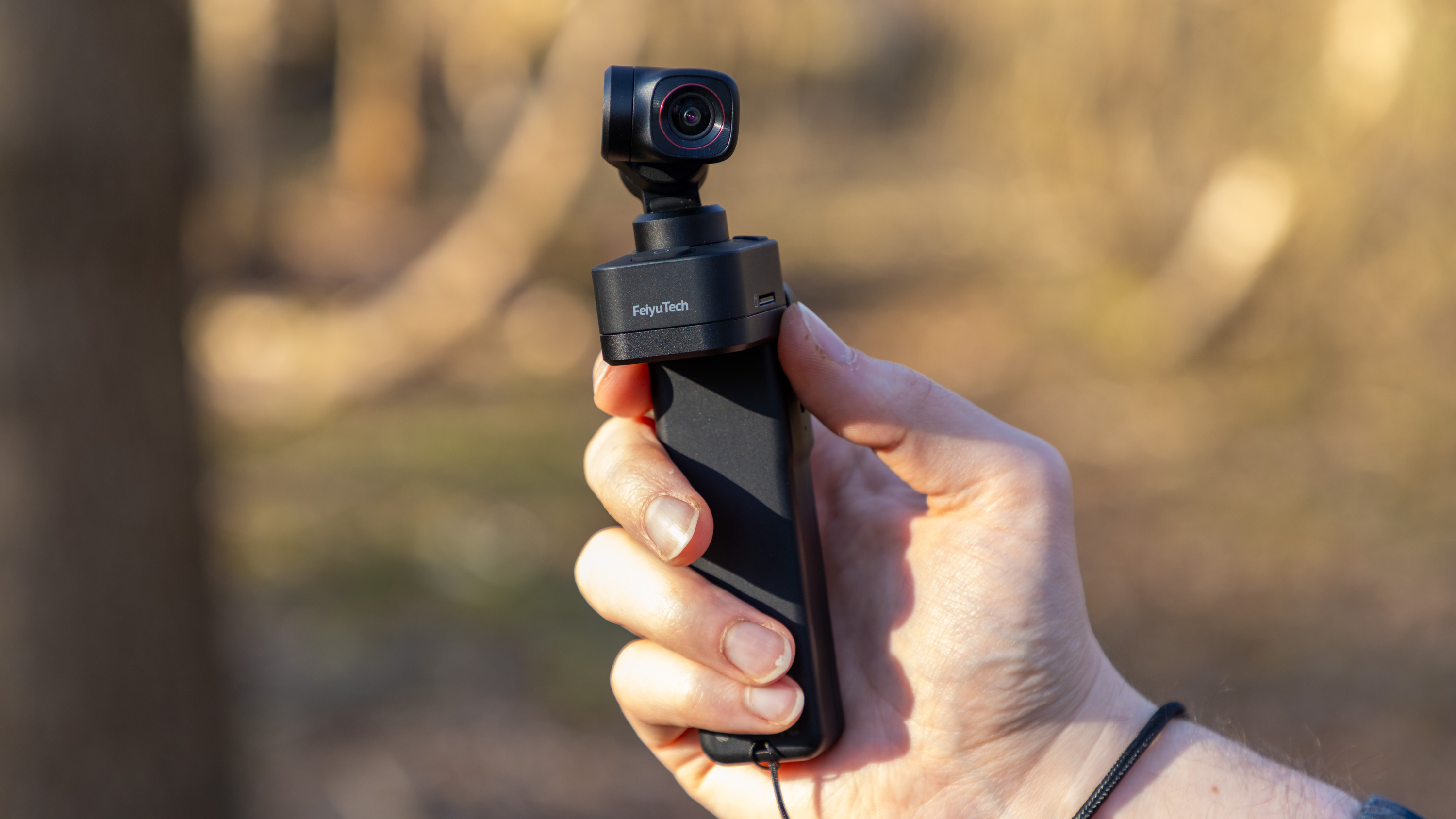
I do have some rather big reservations when it comes to build quality. Let me first say, it all looks to be built to a high standard, with quality materials and feels great in the hand. However, one issue I have is that it’s not weather sealed so you really don’t want to use it in drizzle or rain, and my other sticking point is the connection between the handle and the gimbal head as the male USB-C connection is very exposed and it’s all-to-easy to accidentally misalign the two parts when connecting them which can bend the USB connection if you’re not careful. This is a weak spot users will need to take great care with when attaching the two devices.
I also would have preferred a small locking lever to really cement the two together, as it uses just the USB-C connection and a small ball bearing to keep the two together which works well enough, but I would have liked a little more peace of mind that the two aren’t going to accidentally come apart.
The most obvious comparison for the FeiyuTech Pocket 3 is going to be the DJI Osmo Pocket 3, although in terms of specs and price, it’s probably closer to DJI’s Pocket 2. We can likely expect an updated and specced-up Pocket from FeiyuTech to land at some point in the near future, but as the Pocket 3 is what we currently have, let’s compare it to DJI’s latest offering.
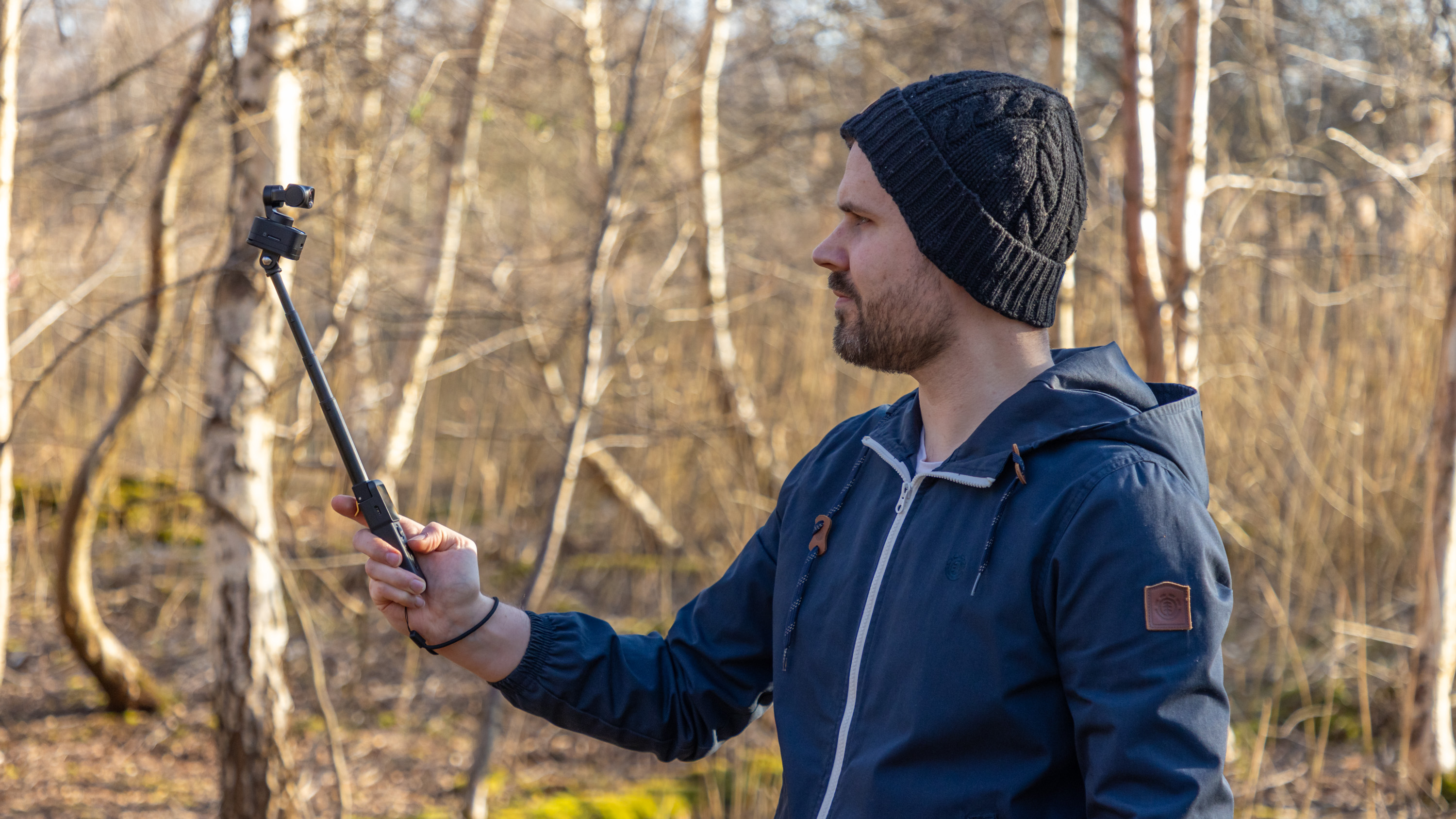
Both Pocket 3 models are vlogging cameras with a three-axis gimbal for handheld stabilization, which looks much more pleasing than the digital stabilization you can do in editing software, which relies on cropping and losing information.
The DJI Osmo Pocket 3 uses a large 1” sensor, while the chip inside the FeiyuTech is smaller at 1/2.3”. This may not sound like much, but in reality, it means the DJI’s sensor is four times the size of that found in the FeiyuTech and one of the first indications of why the DJI model costs so much more.
DJI has really doubled down on pixel size rather than pixel quantity to deliver better low light performance, so even though the DJI sensor is about four times larger, it actually uses fewer, bigger pixels with just 9.4MP for stills, compared to the 12MP of the Feiyu crammed on to that smaller 1/2.3” chip. Pixels act a bit like buckets for catching light, so the DJI's larger pixels should deliver significantly better image quality, particularly in dim conditions, compared to the FeiyuTech, though I’ll cover that in more detail in Performance, where I'll share some video footage I took in London.
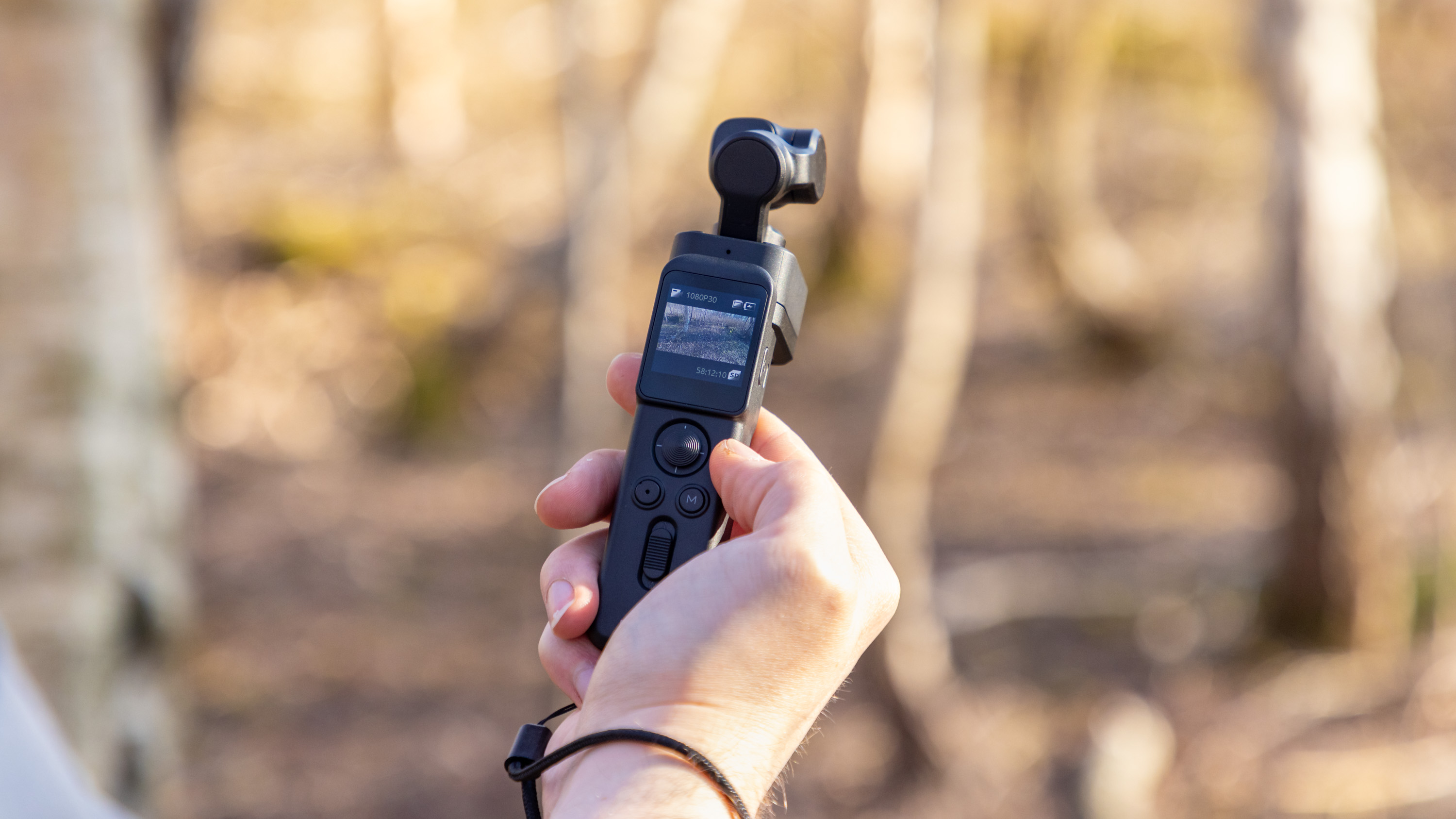
Both the DJI Osmo Pocket 3 and Feiyu Pocket 3 are capable of shooting detailed 4K footage, though the DJI tops out at 120 fps, where the Feiyu maxes out at just 60fps. The bit rate is also slightly faster on the DJI at 130Mbps compared to the 120Mbps of the Feiyu. More importantly, the DJI can shoot 10-bit log for significantly higher amounts of color data compared to the Feiyu’s 8-bit flat.
The FeiyuTech Pocket 3 has an ultra-wide 16mm (35mm equivalent) focal length, whereas the DJI model is a bit more zoomed in at 20mm, though this can be widened to around 15mm with DJI's magnetic adapter. Both vlogging cameras share a bright f/2 aperture which is ideal for sucking in loads of light in low light environments, though the ISO range of the Feiyu is rather limited at just 100-3200, whereas the DJI is much more expansive at 50-16,000.
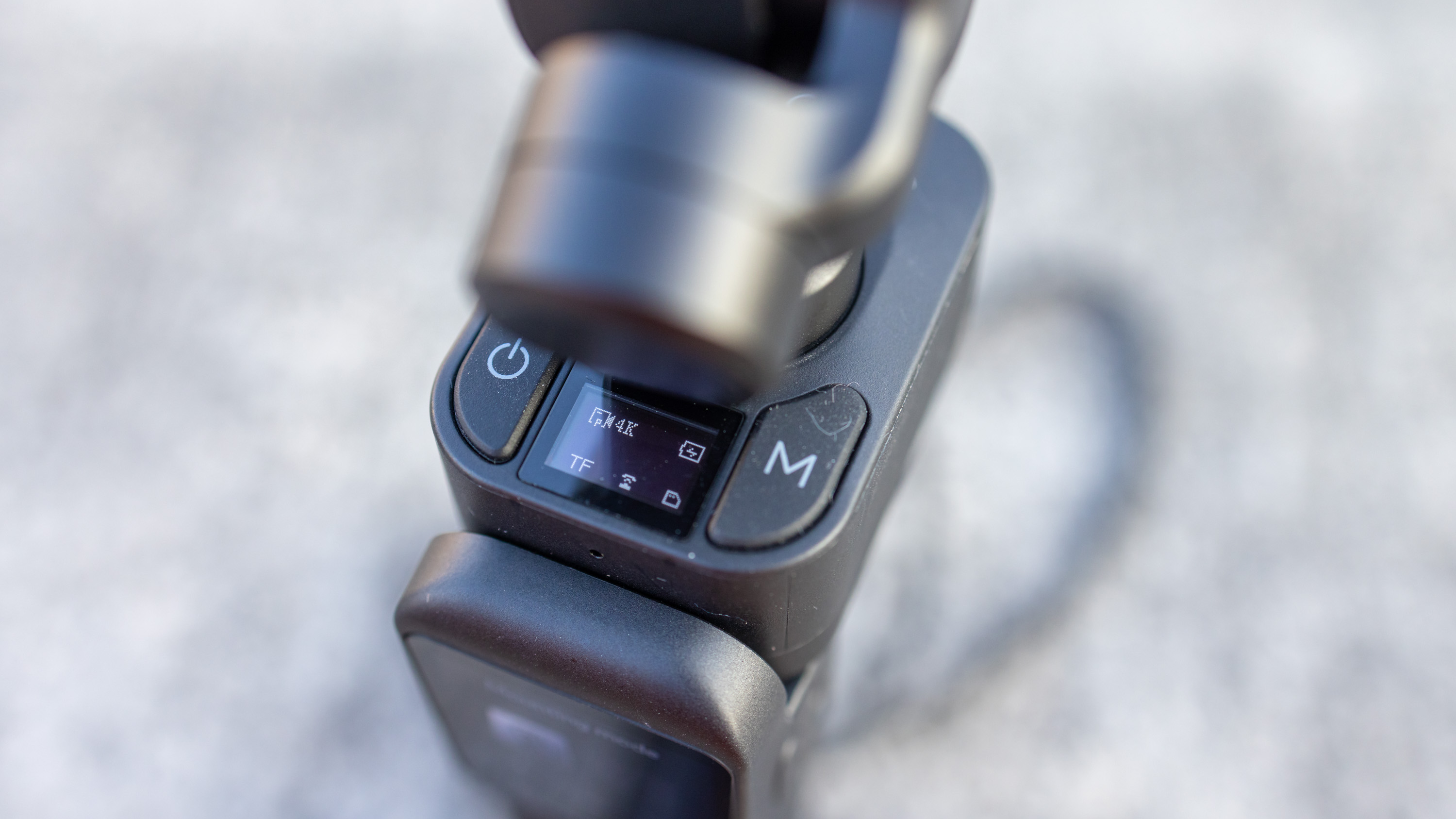
The remote for the FeiyuTech Pocket 3 boasts a 1.3” IPS display which is quite small and hard to view, it’s also fixed in place. The DJI Osmo Pocket 3’s party-trick is that its larger 2” display can be flipped by 90º instantly changing the camera between landscape and portrait orientation recording, with landscape being ideal for Youtube videos and the like, and portrait recording being better for things like TikTok, Facebook and Instagram reels for social media.
When it comes to accessories and peripherals, DJI absolutely trumps the FeiyuTech and this can feel limiting. The DJI Osmo Pocket 3 is available to buy as a Creator Combo, which comes with accessories like a battery grip to provide extra juice, as well as an external microphone. By comparison, the FeiyuTech doesn’t officially support external mics at all – so you’re very reliant on the built-in microphone.
There are also fewer accessories being made for the Feiyu by third parties – for example, there’s a set of ND filters for the DJI model from PolarPro. Accessories that you can buy for the Feiyu Pocket 3 include an expansion base, mini tripod, phone holder, extension pole, and waterproof case.
One cool trick of the Feiyu Pocket 3 is its magnetic base, which allows you to attach it to magnetic metal surfaces such as a lamp post or railing and this is a really neat feature as it means you don’t need to worry about bringing a tripod with you on shoots. Though this obviously works best in urban locations.
Feiyu Pocket 3: Performance
Perhaps I’ve been spoiled by the quality of the DJI Osmo Pocket 3, but in comparison the FeiyuTech Pocket 3 felt a little average. It’s not bad by any means, but footage doesn’t quite ‘pop’ the same way it does on the Osmo, though this is most likely due to the Osmo's 1" sensor which is four times larger and really helps it excel in low light.
For my tests I took the Feiyu Pocket 3 to Trafalgar Square in London at sunset and then to Frameless art gallery for Claire Luxton's latest art installation – both quite dark and contrast heavy scenarios that really put the Feiyu's image quality to the test. Check out my video here with loads of test footage samples including 4K and slow motion at Full HD, both indoors and outside.
The 16mm focal length is nice and wide and makes it really easy to hold the Pocket 3 at arm’s length when attached to the handle, though you can also put it on an extension stick and also ditch the handle altogether and instead use an accessory that allows you to use your phone as the screen – the neat thing about using the Feiyu Cam app to pair it with your phone is you can use your phone’s built in gyroscope to control the direction the gimbal moves in – pretty cool!
There’s no direct way to change the focus, so you have to rely on the Feiyu getting it right, but in my tests, even in low light, the focus always looked pretty spot on. What I would say is that once the light levels dropped, my face did look a little dark when the camera was facing towards me in comparison to the DJI Osmo Pocket 3. This could be down to its larger sensor, in-camera software cleverly giving it a boost, or a mixture of the two.
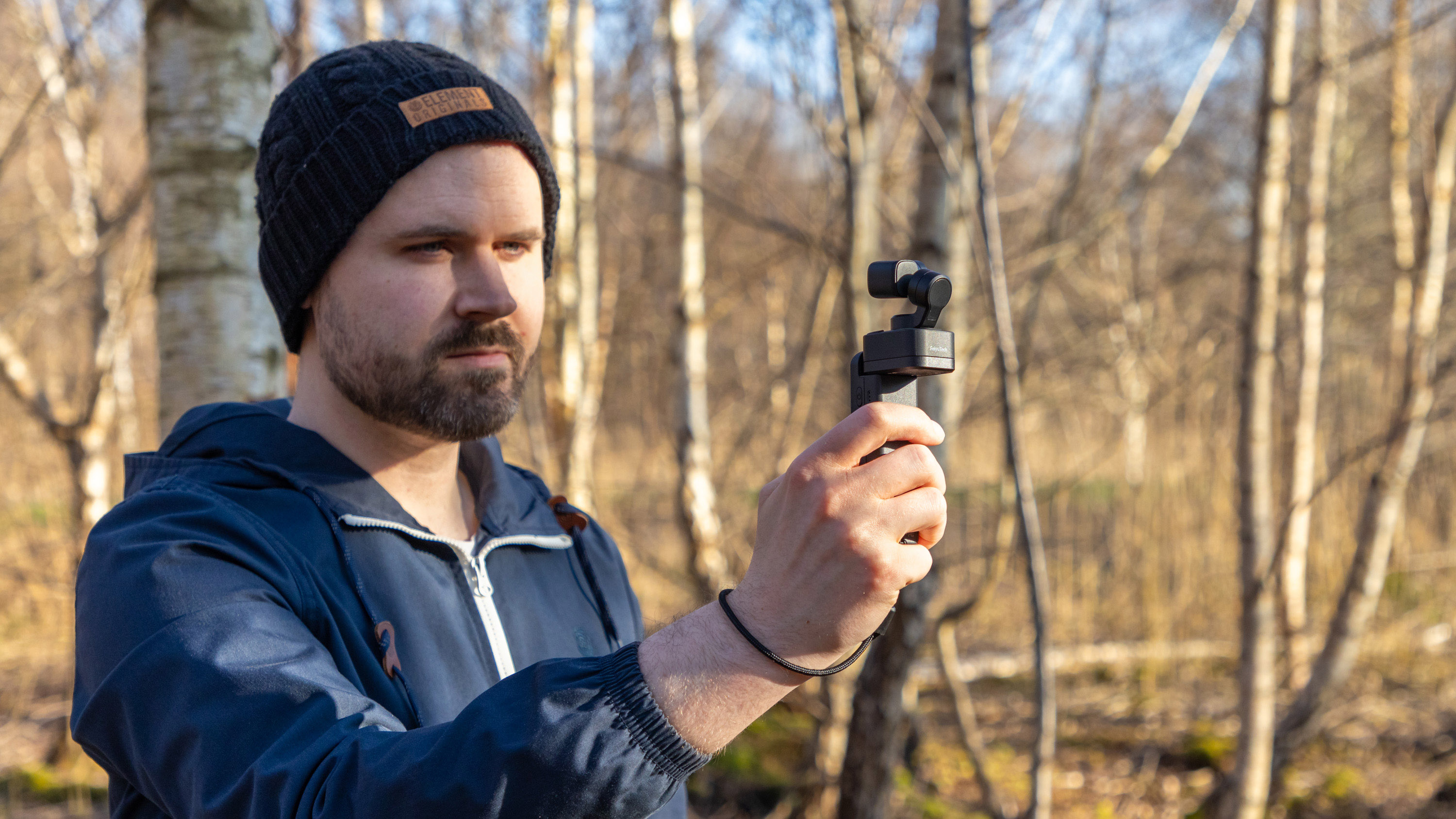
I had good fun playing with the slow motion capabilities, which top out at either 4x Full HD or 8x 720p, though it is disappointing that this is quite lo-res as it doesn’t gel very nicely with the other slick 4K footage it can record. This is yet another area where the DJI Osmo Pocket 3 trounces the Feiyu as it can indeed impressively shoot 4K at 120fps. But I have to keep reminding myself that the Feiyu is half the price of its DJI competitor, so it’s fair to expect it not to be as feature-packed.
One area that impressed, however, was battery life. It’s worth noting that there is a separate battery in the camera gimbal end and another one in the handle if you’re using it. FeiyuTech claims that when using just the camera on its own, you should get about 30 mins when shooting 4K at 60 fps, or 80 mins with the handle attached. I found that to absolutely be the case as my clips from my afternoon vlogging in London (shooting at 4K 60) totted up to 49 mins, and that was just the recorded footage – it was obviously on for a lot longer than this whilst I was wandering around looking for interesting things to record. And when I got home, the battery was still on one-third power. Rather than running two USB-C cables to charge the gimbal and handle independently, you can plug them together and charging just the handle will actually charge up both devices at the same time and should take around 1.5 hours to charge fully with a red LED light turning green to indicate when charging is complete.
The built-in microphone will be your main source of audio as it doesn’t officially support an external mic – even the USB-C to 3.5mm audio adapter which worked with previous Feiyu Pocket versions is not supported here which is a real shame and another area where the DJI Osmo Pocket 3 has one up on its competition. You can even buy a DJI Osmo Creator Combo, which comes with one of DJI’s high-quality wireless mics for superb audio. Considering audio makes up half of your video, I found this to be quite limiting when using the Feiyu.
The design of the Feiyu Pocket 3 isn’t weather-sealed, though it’s not alone in this regard – in fact I can’t think of many sealed gimbals on the market. Presumably, the bearings around the 3-axis control need to be as smooth as possible and potentially adding seals around these points could introduce friction. Regardless, it’s a weakness not just for the Feiyu, but for many gimbal devices like these – though the Feiyu is perhaps a little more exposed to the elements than others as it has that extra USB-C connection point between the camera gimbal head and handle. The microSD card slot also looks like another weak point where water could get in. That said, there is a waterproof case for the Pocket 3 so you can take it underwater, though it’s not cheap at $150.
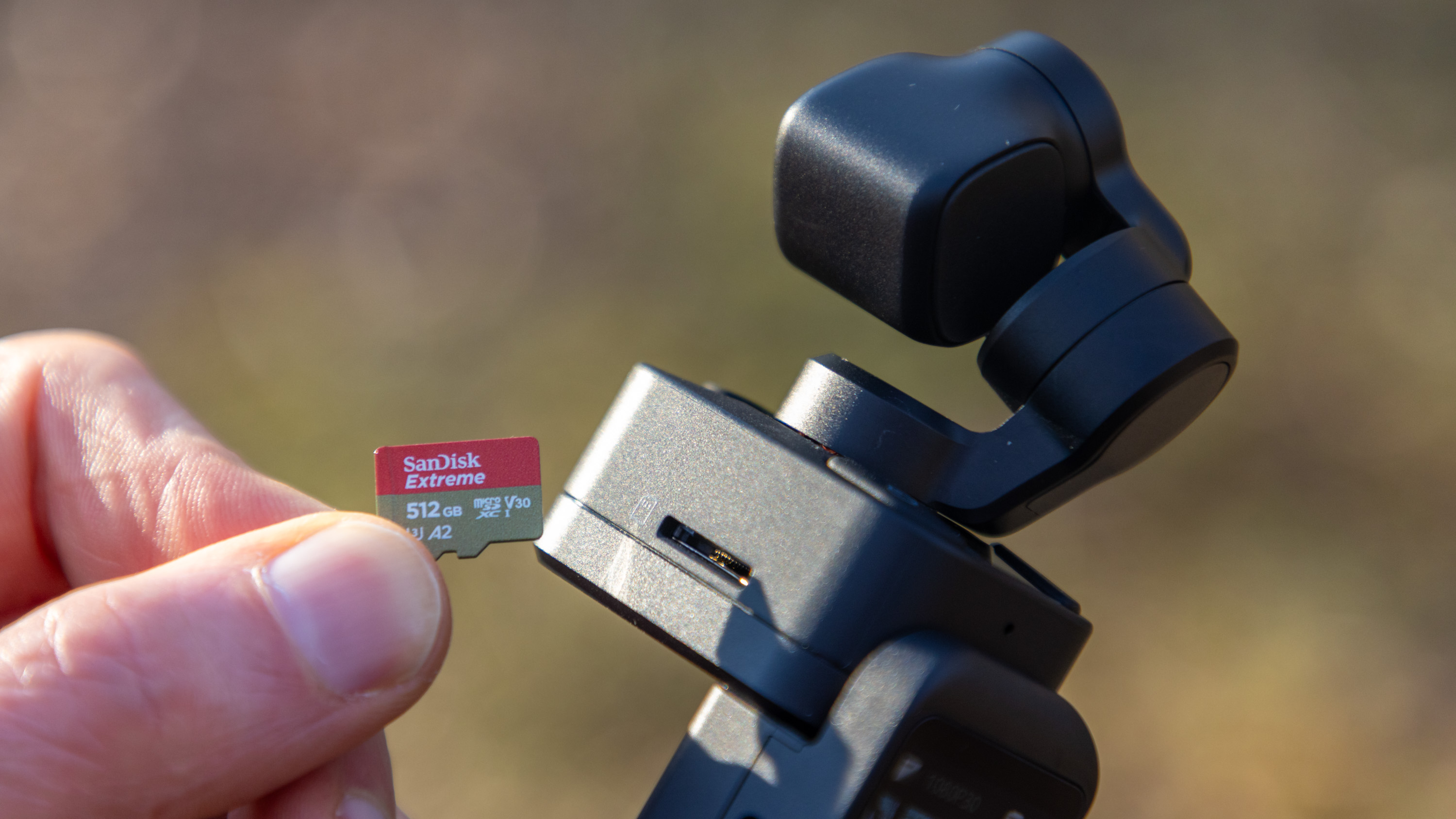
Speaking of the microSD port – I was surprised to learn that the Feiyu only supports up to 512GB microSD cards, though this is apparently the norm as it’s the same on the DJI Osmo Pocket 3 too. With 1TB and even 2TB microSD cards now on the market, I would have liked to seen support for these higher capacity cards to really make use of all that 4K video which eats up memory card space like no tomorrow, hopefully we’ll get this on the Feiyu’s next generation Pocket when it comes out.
So we’ve covered most of the big stuff – now I’ll quickly run through some of the things I didn’t like on test... The zoom is digital only (up to four times) and is often locked off depending on what shooting mode you’re in, the screen is very small on the handle and it can be difficult to see what you’re doing, touch support is also a bit unreactive and the menus on the interface are a little unclear on what settings can be swiped to be adjusted – a few arrows on each side of settings to show they can be pulled up or down would greatly clear this up. I couldn’t find an easy way to flip between landscape orientation and portrait for recording reels – on the DJI Osmo you just flip the screen which is really easy, and I also found the gimbal movement to be a bit jerky and hard to achieve a smooth action with it, I couldn't see a setting in the menu to reduce the sensitivity of the joystick so it always panned a bit too quickly. It’s also a little slow to turn on at get going, taking six secs with the camera and handle connected, but a slower 17 secs when they’re separated as they have to be connected over Wi-Fi.
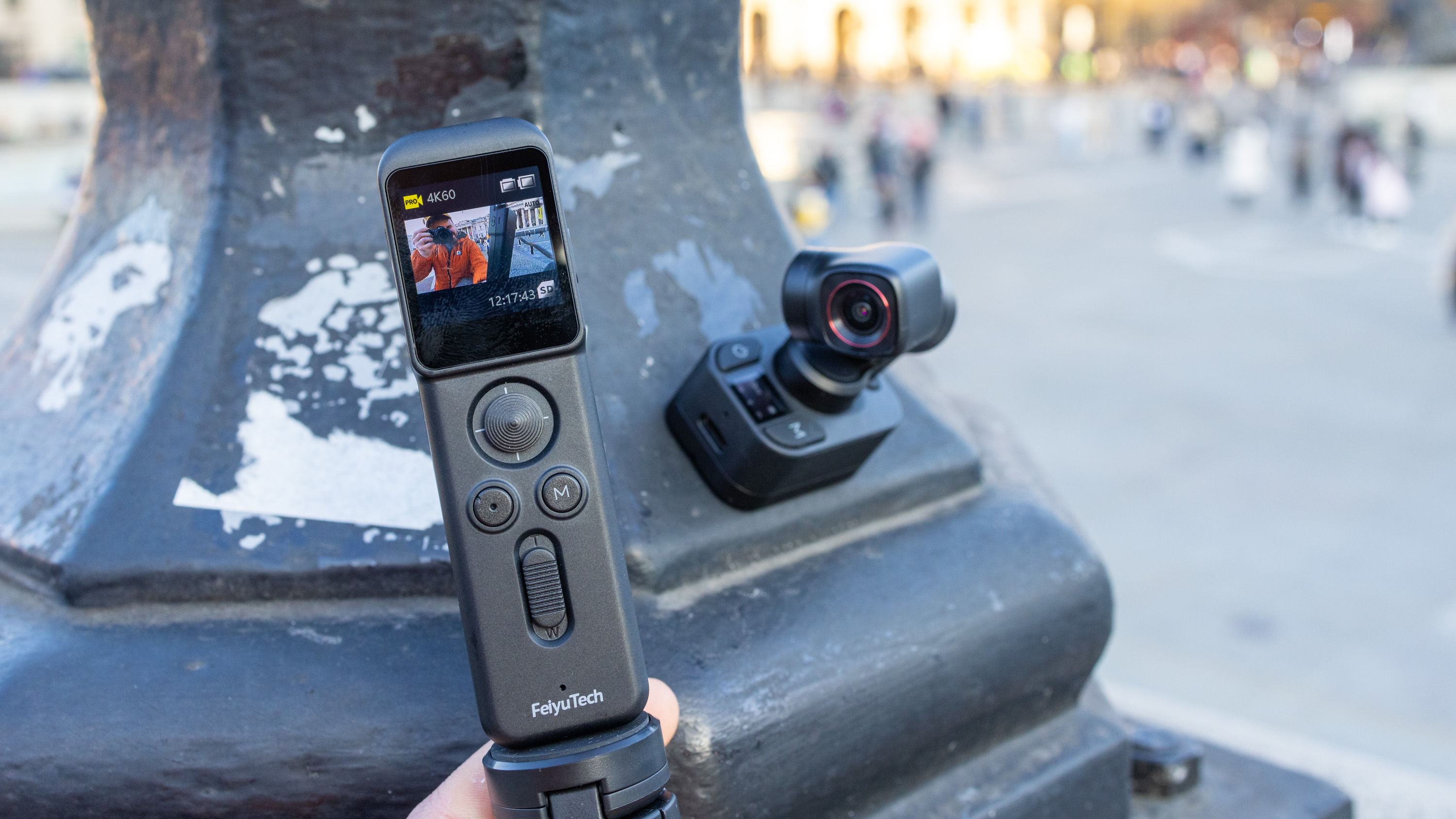
Okay so those were my quickfire pet peeves and I’ll end on some quick positives that really impressed me. The ability to detach the camera from the handle isn’t just a gimmick – it’s genuinely useful for quick guerilla-style filmmaking without the need for a tripod and its magnetic base makes it easy to attach to a metal lamppost, railing or even the roof of a car! The wireless range impressed and when using the camera away from the remote the connection always stayed strong in my tests. The face tracking also impressed as it always appeared to make sure I was in focus with the camera pointing towards me and it has a wide set of modes to choose from in the menu to change it from follow mode to panning and pressing the M button cycles through them quickly, pressing it twice recenters the gimbal and pressing it three times flips the camera around 180º so it's easy to operate.
Feiyu Pocket 3: Verdict
Whilst the Feiyu Pocket 3 shares a similar name with its competition from DJI’s Osmo Pocket 3, it’s a completely different proposition. The DJI Osmo Pocket 3 is over twice the price, but you are getting more for your money – its larger sensor, microphone support, wide gamut of accessories available for it and low light performance all go some ways to justifying the extra spend.
However, what the Feiyu Pocket 3 lacks in image quality, dynamic range and audio options, it makes up for it with its unique design that sees its gimbal head completely detachable from its handle and a magnetic base that allows you to position it on a magnetic metal surface like a lamppost or car roof – opening up some pretty creative framing choices in urban locations. It’s also half the price of the DJI Osmo Pocket 3, so if your budget can only stretch to $279, or a stricter budget of just $199 if you want to use your phone as a screen instead of the Feiyu handle, then that might be the factor that helps you make up your mind.
Feiyu's Pocket 3 will be a great budget-friendly entry point for those just starting out in vlogging to get some experience recording and editing videos together and also allow you to get creative compositions you simply can't do with even more expensive gimbals on the market.
Features | The Feiyu Pocket 3 is a budget-friendly vlogging camera with a detachable gimbal, magnetic base, 4K video, and limitations. | ★★★☆☆ |
Design | The Feiyu Pocket 3 has a detachable gimbal with wireless control, magnetic base, USB-C connection, and no weather sealing. | ★★★★☆ |
Performance | The Feiyu Pocket 3 offers decent video, reliable autofocus, good battery life, but struggles in low light and lacks mic support. | ★★★☆☆ |
Value | The Feiyu Pocket 3 is an affordable alternative with detachable gimbal, magnetic base, good battery, but lower video quality overall. | ★★★★☆ |
Alternatives
While the Pocket series has a unique portable quality, we also have guides to the best gimbals for phones and the best gimbals for mirrorless & DSLR cameras.

Deputy Editor on PhotoPlus: The Canon Magazine, Dan also brings his technical wizardry and editing skills to Digital Camera World. He has been writing about all aspects of photography for over 10 years, having previously served as technical writer and technical editor for Practical Photography magazine, as well as Photoshop editor on Digital Photo.
Dan is an Adobe-certified Photoshop guru, making him officially a beast at post-processing – so he’s the perfect person to share tips and tricks both in-camera and in post. Able to shoot all genres, Dan provides news, techniques and tutorials on everything from portraits and landscapes to macro and wildlife, helping photographers get the most out of their cameras, lenses, filters, lighting, tripods, and, of course, editing software.
You must confirm your public display name before commenting
Please logout and then login again, you will then be prompted to enter your display name.
